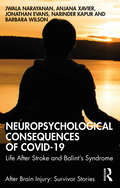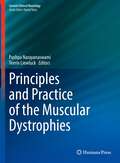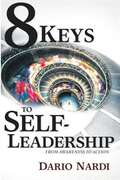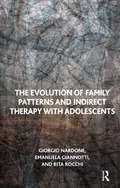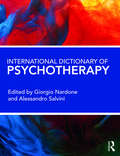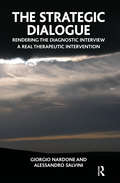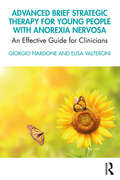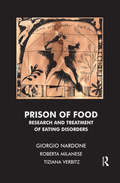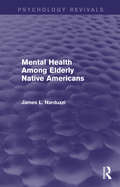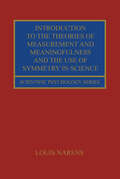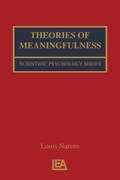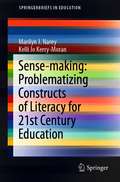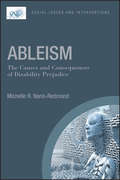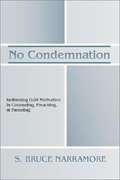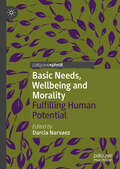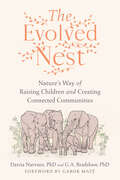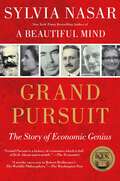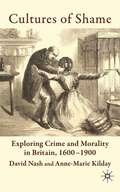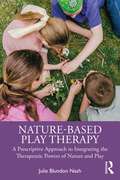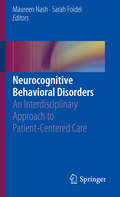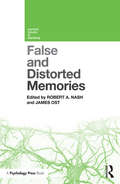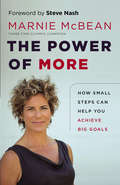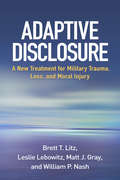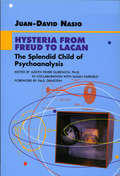- Table View
- List View
Neuropsychological Consequences of COVID-19: Life After Stroke and Balint's Syndrome (ISSN)
by Jwala Narayanan Anjana Xavier Jonathan Evans Narinder Kapur Barbara WilsonNeuropsychological Consequences of COVID-19 focuses on Anjana’s journey as a COVID survivor following a brain injury that left her with a very rare neuropsychological syndrome called Balint’s syndrome, a disorder associated with difficulties in visual and spatial coordination. It is also the first book of its kind to provide a first-hand account from India on surviving brain injury, from diagnosis, recovery and rehabilitation, providing the therapeutic milieu in the Indian context and exploring cultural influences on rehabilitation.Written jointly by Anjana, her neuropsychologist and the international experts in the field of neuropsychology who were also involved in her diagnosis and care, the book highlights how COVID-19, a virus primarily affecting the respiratory system, can also result in a disabling brain injury. It describes Anjana’s recovery and the rehabilitation she received and provides a deeper understanding of this experience of a very rare condition through the views of Anjana herself. In addition, Anjana’s rehabilitation journey stumbles upon many important themes of rehabilitation including cultural sensitivity, personal identity, resilience, role of family and rehabilitation in a low to middle income country.This book is valuable reading for clinical and neuropsychologists, neurologists, other rehabilitation therapists including physiotherapists, occupational therapists, nurses and social work professionals, particularly those interested in cross cultural rehabilitation. It will also be of interest to students in these fields.
Principles and Practice of the Muscular Dystrophies (Current Clinical Neurology)
by Pushpa Narayanaswami Teerin LiewluckThe field of muscular dystrophies has expanded significantly with the discovery of the genetic defects and protein products underlying these disorders. New treatments such as antisense oligonucleotides and siRNAs and gene therapies are now in clinical application and in trials. As clinical trials increase, outcome measurement becomes very important, and more validated tools are being developed. This book provides a comprehensive review of these disorders. Clinical features, diagnostic testing including genetic testing of these disorders, the basis and utility of genetic testing, and the basis of genetic therapies are all covered in detail. This book will provide neuromuscular neurologists, general neurologists, and neuromuscular fellows with a much needed update in the field.
8 Keys To Self-Leadership: From Awareness To Action
by Dario Nardi8 Keys to Self-Leadership shows you how to honor your natural talents and to stretch yourself into new areas while keeping that sense of learning and wonder you had as a child. In this book, you will be guided through the doors of self-awareness and shown how to unlock the eight ways to find greater satisfaction in all that you do. If you are familiar with Dr. Carl Jung's framework of 8 psychological functions or the 16 Myers-Briggs types, you will find familiar material, though this book takes a developmental approach. Each chapter takes you through one of eight ways we metabolize experiences, including a quiz, in-depth explanation, and two-dozen exercises to explore and develop the benefits of that psychological function in yourself. Everything is based upon extensive research, discussions with multiple experts, and practical experience with clients. This book is a great tool to use on your own or with clients for coaching and skills and leadership development.
The Evolution of Family Patterns and Indirect Therapy with Adolescents
by Giorgio Nardone Emanuela Giannotti Rita RocchiThis text presents a picture of contemporary family patterns that might produce problems of social and psychopathologic deviance in adolescents. It is the outcome of the teamwork of 32 researchers and therapists, members of the Centre of Strategic Therapy in Arezzo. This work was put together over a period of five years, where the research-intervention group met on a monthly basis under the author's personal supervision, to put together the data gathered from thousands of cases of disturbed adolescents with the aim of better the application of specific strategic interventions in parent-child problematics. The purpose of this book is to point out clearly how some problems of contemporary adolescents can be triggered off and how they can be prevented or solved. It is meant to be a training text for specialists but it is also reader-friendly and can be appreciated both by parents and children so that both can come to avoid the traps hidden in relationships and their dysfunctional aspects. In other words, the aim is to 'correct' "the best intentions that produce the worst effects".
International Dictionary of Psychotherapy
by Giorgio Nardone Alessandro SalviniThe International Dictionary of Psychotherapy is a systematized compendium of the numerous psychotherapies that have evolved over the past 30 years. With contributions from over 350 experts in the field, it highlights the diverse schools of psychotherapy, tracing their histories and traditions, while underlining their specific strengths in dealing with human behaviours, feelings and perceptions in the contemporary world. The book traces eight principal paradigms: psychodynamic, behavioural, existential-humanistic, body-expression, systemic-relational, cognitive, interactional-strategic and eclectic. It presents to the expert and non-expert reader an array of models that grew from a specific paradigm, sharing the same fundamental epistemology and therapeutic strategies. This is accomplished through a reader-friendly approach that presents clear definitions of the key constructs of each paradigm, and transversal concepts that are common to the diverse practices of psychotherapy. The International Dictionary of Psychotherapy provides a clear picture of the numerous types of psychotherapeutic treatments and their applications, while offering a close examination of the efficacy and evaluative methods developed as a result of numerous debates and research carried out within the psychotherapeutic community. It represents an essential resource for psychotherapeutic and psychoanalytic practitioners and students, regardless of background or creed.
The Strategic Dialogue: Rendering the Diagnostic Interview a Real Therapeutic Intervention
by Giorgio Nardone Alessandro SalviniThe Strategic Dialogue is a fine strategy by which one can achieve maximum results with minimum effort. It was developed through a natural evolutionary process from previous treatments for particular pathologies, and composed of therapeutic stratagems and specific sequences of ad hoc maneuvres constructed for different types of problems. This book represents both the starting and finishing line of all of the research, clinical practice, and managerial consulting performed by the authors over a fifteen year period at the Centro Terapia Strategica of Arezzo (Strategic Therapy Center). This work can be referred to as the finishing line because the Strategic Dialogue, an advanced therapeutic method of conducting a therapy session and inducing radical changes rapidly in the patient, represents the culmination of all that has been achieved so far in the field.
Advanced Brief Strategic Therapy for Young People with Anorexia Nervosa: An Effective Guide for Clinicians
by Giorgio Nardone Elisa ValteroniThis important new book details a strategic and systemic model for short-term therapy with adolescent sufferers of anorexia nervosa, a psychopathology that seduces patients into starvation as doctors and family look on with increasing desperation. Supported by the successful treatment of hundreds of cases over the past 30 years, the book is the culmination of a long-term intervention programme developed at the Strategic Therapy Centre of Arezzo, Italy. It begins by outlining the range of different eating disorders, before identifying the specific characteristics that adolescents with anorexia present. The variations of the pathology are then discussed. Not all patients present with the same symptoms; some sufferers over-exercise while others binge eat or self-harm. Substance abuse is also common, either with diuretics or chemicals; others self-induce vomiting. The therapeutic strategy will, of course, differ for each patient. Accessibly written throughout, the book concludes with two cases studies – complete with full transcripts – which illustrate the therapeutic process that allowed the patient to change their patterns of thinking, and the accompanying behaviours. An insightful and invaluable work on this vital topic, the book will be essential reading for any professional working with adolescents presenting with anorexia, as well as the families of sufferers.
Prison of Food: Research and Treatment of Eating Disorders
by Giorgio Nardone Tiziana Verbitz Roberta MilaneseThis groundbreaking volume concentrates on solution-oriented treatment of some of the most difficult pathologies - anorexia, bulimia and vomiting (as a separate category introduced by Nardone et al). The logic and apparent simplicity of the way these complex conditions are treated is truly outstanding. As opposed to a long-drawn psychotherapy, Nardone and his colleagues offer a relatively short period of treatment, consisting of dialogue between the patient and the therapist, and sometimes the patient's family. The patient is also given some "homework" to do in-between the sessions. Rather than looking at the "why" of the situation, this approach looks at "how" the problem manifests itself and what can be done about it. The book starts by outlining the pathologies and the logic behind this type of brief therapy. It then moves on to examine particular case studies and the reader gets immersed in the fascinating dialogue between the therapist and the client.
Mental Health Among Elderly Native Americans (Psychology Revivals)
by James L. NarduzziIn the 1990s providing mental health services to the elderly and particularly to elderly Native Americans had been an issue of some concern for the last several decades. Despite this, many public decisions made at the time were based on inadequate data. Due to this lack of data, there had been little research devoted to determining the factors associated with mental health among elderly Native Americans. Instead, the growing body of mental health research had "been based on limited samples, primarily of middle-majority Anglos." Originally published in 1994, the purpose of this research was to utilize existing data to close the gap in our understanding of mental health among elderly Native Americans.
Introduction to the Theories of Measurement and Meaningfulness and the Use of Symmetry in Science (Scientific Psychology Ser.)
by Louis NarensThis book is designed to be an introduction to the theories of measurement and meaningfulness, and not a comprehensive study of those topics. A major theme of this book is the psychophysical measurement of subjective intensity. This has been a subject of intense interest in psychology from the very beginning of experimental psychology. And from tha
Theories of Meaningfulness (Scientific Psychology Series)
by Louis NarensWritten by one of the masters of the foundation of measurement, Louis Narens' new book thoroughly examines the basis for the measurement-theoretic concept of meaningfulness and presents a new theory about the role of numbers and invariance in science. The book associates with each portion of mathematical science a subject matter that the portion of science is intended to investigate or describe. It considers those quantitative or empirical assertions and relationships that belong to the subject matter to be meaningful (for that portion of science) and those that do not belong to be meaningless. The first two chapters of the Theories of Meaningfulness introduce meaningfulness concepts, their place in the history of science, and some of their traditional applications. The idea that meaningfulness will have different, but interrelated uses is then introduced. To provide formal descriptions of these, the author employs a powerful framework that incorporates pure mathematics, provides for qualitative objects and relations, and addresses the relationships between qualitative objects and pure mathematics. The framework is then applied to produce axiomatic theories of meaningfulness, including generalizations and a new foundation for the famous Erlanger Program of mathematics. The meaningfulness concept is further specialized with the introduction of intrinsicness, which deals with meaningful concepts and relations that are lawful and qualitativeness, which is concerned with qualitative concepts. The concept of empiricalness is then introduced to distinguish it from meaningfulness and qualitativeness. The failure to distinguish empiricalness from meaningfulness and qualitativeness has produced much confusion in the foundations of science literature and has generated many pseudo-controversies. This book suggests that many of these disappear when empiricalness is intersected with the other concepts to produce "meaningful and empirical relations," "empirical laws," and "qualitative and empirical concepts." A primary goal of this book is to show that the new theories of meaningfulness and intrinsicness developed in this book are not only descriptive but are also potent. Asserting that they do more than codify already existing concepts the book: *works out logical relationships between meaningfulness concepts that were previously unrecognized; *clarifies certain well-known and important debates by providing rich languages with new concepts and technical results (theorems) that yield insights into the debated issues and positions taken on them; and *provides new techniques and results in substantive scientific areas of inquiry. This book is about the role of mathematics in science. It will be useful to those concerned with the foundations of science in their respective fields. Various substantive examples from the behavioral sciences are presented.
Sense-making: Problematizing Constructs of Literacy for 21st Century Education (SpringerBriefs in Education)
by Marilyn J. Narey Kelli Jo Kerry-MoranThis book is a rich, yet highly accessible volume that details an exciting and much-needed inquiry into the notion of literacy: what it is, why it is, and how it might be framed most effectively for 21st century education. The chapters unfold in a creative interplay of practice and theory. Narey’s insightful questioning into the socio-historical-cultural implications of “literacy as empowerment” establishes the critical context, while Kerry-Moran’s examination of the burgeoning literacy landscape reveals challenges for teacher education. Drawing upon classic and cutting-edge theories, Narey builds a provocative and powerful case for a 21st century construct of literacy as sense-making: sense as relative to the senses (i.e., sight, hearing) and sense as making meaning. Her innovative model of the literacy event opens up a range of potential foci for analysis and facilitates her teasing out of two critical areas for instruction: sensory perception and aesthetic knowledge. This theoretical sense-making lens is applied to Kerry-Moran’s teacher education classroom as the authors reflect upon further development. As a timely original and thought-provoking work, this slim volume of big ideas promises to be a valuable resource for teacher educators and other scholars who seek a clear and cohesive frame for literacy in 21st century education. This is a very well written scholarly text that provides a new and important theory of 21st century literacy. Narey’s sketches of literacy as sense-making are laid out in logical form, building upon researched and referenced sources to ground her ideas and offering the reader information, examples and new insights. In addition to providing many significant perspectives underpinning her new theory, Narey provides excellent historical and current explanations about literacy from highly respected researchers in the field. The inclusion of a practical application of Narey’s conceptual/theoretical framework to Kerry-Moran's example of an instructional unit in a teacher education course is helpful to understanding the theory in practice. The references throughout the work are extensive, comprehensive and very well documented. This text, Sense-making: Problematizing Constructs of Literacy for 21st Century Education, contributes original thinking to the field of literacy and learning and would be an excellent resource for literacy and language professors or instructors in a post-graduate or professional development program.Penny Silvers, Professor of Education, Dominican University, USA
Ableism: The Causes and Consequences of Disability Prejudice (Contemporary Social Issues)
by Michelle R. Nario-RedmondThe first comprehensive volume to integrate social-scientific literature on the origins and manifestations of prejudice against disabled people Ableism, prejudice against disabled people stereotyped as incompetent and dependent, can elicit a range of reactions that include fear, contempt, pity, and inspiration. Current literature—often narrowly focused on a specific aspect of the subject or limited in scope to psychoanalytic tradition—fails to examine the many origins and manifestations of ableism. Filling a significant gap in the field, Ableism: The Causes and Consequences of Disability Prejudice is the first work to synthesize classic and contemporary studies on the evolutionary, ideological, and cognitive-emotional sources of ableism. This comprehensive volume examines new manifestations of ableism, summarizes the state of research on disability prejudice, and explores real-world personal accounts and interventions to illustrate the various forms and impacts of ableism. This important contribution to the field combines evidence from multiple theoretical perspectives, including published and unpublished work from both disabled and nondisabled constituents, on the causes, consequences, and elimination of disability prejudice. Each chapter places findings in the context of contemporary theories—identifying methodological limits and suggesting alternative interpretations. Topics include the evolutionary and existential origins of disability prejudice, cultural and impairment-specific stereotypes, interventions to reduce prejudice, and how to effect social change through collective action and advocacy. Adopting a holistic approach to the study of disability prejudice, this accessibly-written volume: Provides an inclusive, up-to-date exploration of the origins and expressions of ableism Addresses how to resist ableist practices, prioritize accessible policies, and create more equitable social relations with pages earmarked for activists and allies Focuses on interpersonal and intergroup analysis from a social-psychological perspective Integrates research from multiple disciplines to illustrate critical cognitive, affective and behavioral mechanisms and manifestations of ableism Suggests future research directions based on topics covered in each chapter Ableism: The Causes and Consequences of Disability Prejudice is an important resource for social, community and rehabilitation psychologists, scholars and researchers of disability studies, and students, activists, and academics across political, sociological, and humanistic disciplines.
How to Handle Pressure
by Clyde M. Narramore Ruth E. NarramoreBack Cover: "pressure seems to be an unavoidable element of modern-day life. We can't escape it. In fact, many of us have not learned to cope successfully with the variety of pressures that come our way. In this book the Narramores suggest practical solutions for Christians seeking to handle pressure. They discuss such issues as time and money management, physical fitness, setting realistic goals, having a confidant to share our burdens, and living an organized life. These pave the way to peace of mind and contented living." Unlike other books of this genre, the Narramores integrate their psychology within a Christian worldview by quoting scripture references and referring to Biblical concepts from both the Old and New Testament. However, because this book has a psychological foundation to it, the non-Christian can gain insights by concentrating on the psychological information and by ignoring the Christian content.
No Condemnation: Rethinking Guilt Motivation In Counseling, Preaching, And Parenting
by S. Bruce NarramoreNo Condemnation: Rethinking Guilt Motivation in Counseling, Preaching, and Parenting <P><P> <br>Part 1: The Repression of Guilt <br>Part 2: Perspectives on Guilt and Conscience <br>Part 3: Christian Motivation of Neurotic Masochism <br>Part 4: Christ and Conscience
Basic Needs, Wellbeing and Morality: Fulfilling Human Potential
by Darcia NarvaezBasic needs fulfilment is fundamental to becoming human and reaching one’s potential. Extending the BUCET list proposed by Susan Fiske - which includes belonging, understanding, control/competence, autonomy, self-enhancement, trust, purpose and life satisfaction - this book demonstrates that the fulfilment of basic needs predicts adult physical and mental health, as well as sociality and morality. The authors suggest that meeting basic needs in childhood vitally shapes one’s trajectory for self-actualization, and that initiatives aimed at human wellbeing should include a greater emphasis on early childhood experience. Through contemporaneous and retrospective research in childhood, the authors argue that basic need-fulfilment is key to the development of the self and the possibility of reaching one’s full potential. This book will be of interest to scholars of human wellbeing and societal flourishing, as well as to health workers and educators.
The Evolved Nest: Nature's Way of Raising Children and Creating Connected Communities
by Darcia Narvaez G. A. BradshawA fascinating look into nurturing and parenting in the natural world, supplemented with original illustrationsFor readers of Becoming Animal and World of WondersA beautiful resource for Nature advocates, parents-to-be, Animal lovers, and anyone who seeks to restore wellbeing on our planet, The Evolved Nest reconnects us to lessons from the Animal world and shows us how to restore wellness in our families, communities, and lives.Each of 10 chapters explores a different animal&’s parenting model, sharing species-specific adaptations that allow each to thrive in their &“evolved nests.&” You&’ll learn:How Wolves build an internal moral compassHow Beavers foster a spirit of play in their childrenHow Octopuses develop emotional and social intelligenceHow, when, and whether (or not) Brown Bears decide to have childrenWhat their lessons can teach you--whether you&’re a parent, grandparent, caregiver, or childfreePsychologists Drs. Darcia Narvaez and Gay Bradshaw show us how each evolved nest offers inspiration for reexamining our own systems of nurturing, understanding, and caring for our young and each other. Alongside beautiful illustrations, stunning scientific facts, and lessons in neuroscience, psychology, and evolutionary biology, we learn to care deeper: to restore our innate place within the natural world and fight for an ecology of life that supports our flourishing in balance with Nature alongside our human and non-human family.
Grand Pursuit: The Story of Economic Genius
by Sylvia NasarIn a sweeping narrative, the author of the megabestseller A Beautiful Mind takes us on a journey through modern history with the men and women who changed the lives of every single person on the planet. It’s the epic story of the making of modern economics, and of how economics rescued mankind from squalor and deprivation by placing its material fate in its own hands rather than in Fate. Nasar’s account begins with Charles Dickens and Henry Mayhew observing and publishing the condition of the poor majority in mid-nineteenth-century London, the richest and most glittering place in the world. This was a new pursuit. She describes the often heroic efforts of Marx, Engels, Alfred Marshall, Beatrice and Sydney Webb, and the American Irving Fisher to put those insights into action—with revolutionary consequences for the world. From the great John Maynard Keynes to Schumpeter, Hayek, Keynes’s disciple Joan Robinson, the influential American economists Paul Samuelson and Milton Freedman, and India’s Nobel Prize winner Amartya Sen, she shows how the insights of these activist thinkers transformed the world—from one city, London, to the developed nations in Europe and America, and now to the entire planet. In Nasar’s dramatic narrative of these discoverers we witness men and women responding to personal crises, world wars, revolutions, economic upheavals, and each other’s ideas to turn back Malthus and transform the dismal science into a triumph over mankind’s hitherto age-old destiny of misery and early death. This idea, unimaginable less than 200 years ago, is a story of trial and error, but ultimately transcendent, as it is rendered here in a stunning and moving narrative.
Cultures of Shame
by David Nash Anne-Marie KildayThe first systematic study of the concept of shame from 1600-1900, showing good and bad behaviour, morality and perceptions of crime in British society at large. Single episodes in the history of shame are contextualized by discussing the historiography and theory of shame and their implications for the history of crime and social relations.
Nature-Based Play Therapy: A Prescriptive Approach to Integrating the Therapeutic Powers of Nature and Play
by Julie Blundon NashNature-Based Play Therapy brings a theoretical basis to arguments for including nature in play therapy and provides tools for that inclusion with a prescriptive model. Throughout this book, play therapists are introduced to the histories of nature and play across cultures and cultural expectations and are then guided into an understanding of how nature and play intersect with current trends in society and psychotherapy. Readers will learn about how the therapeutic powers of play are activated and facilitated by the inclusion of nature in play therapy, and they will be taken step-by-step through a prescriptive case conceptualization model. They’ll also find case studies that link theoretical tenets, the therapeutic powers and play and nature, and intended treatment outcomes. Nature-Based Play Therapy is an excellent introduction to a vital and growing area of the field, one that gives a well-rounded summary to a theoretically based model of treatment.
Neurocognitive Behavioral Disorders: An Interdisciplinary Approach to Patient-Centered Care
by Maureen Nash Sarah FoidelDementia, now known as major neurocognitive disorder, is not one monolithic disease. Nor is behavior disturbance driven by one particular neurocognitive dysfunction. In fact if we are able to understand it, behavior is an excellent form of nonverbal communication. There are many different causes of dementia. A major challenge with both researching and implementing interventions is viewing dementia and related behaviors as single entities. This approach leaves room for critical errors in the treatment of dementia patients, beginning with misdiagnosis. This book approaches dementia by reviewing cognitive and functional assessments to provide a more accurate diagnosis, which then allows physicians to design specific interventions that are tailored to the person and their challenges. Because person centered care is vital to quality of life and longevity to an aging patient, this understanding of individual needs is vital. Written by experts in the field, this book incorporates the latest evidence-based behavioral interventions matched to specific deficits. Behavioral management focuses not on controlling behavior, but using it to teach staff and caregivers how to interpret common actions and maximize function for people with major neurocognitive disorders. Quality of life and individualized care planning will be the theme and the book will provide practical case examples. The book begins by introducing dementia and other neurocognitive illnesses, contextualizing them both historically and contemporarily. Next, the text focuses on the comprehensive assessment of a person with neurocognitive challenges in order to identify strengths and understand what the person is trying to communicate with their behavior. This process allows individualized care planning and behavioral (non-pharmacologic) management to meet the cognitive challenges and maximize individual strengths and thereby improve outcomes, making this a cutting edge resource.
False and Distorted Memories (Current Issues in Memory)
by Robert A. Nash James OstOur memories shape how we think about the past, how we plan for the future, and how we think about ourselves. Yet our memories are also constantly being reinvented: we often remember our experiences differently from how they truly happened, and can even remember experiences that never happened at all. ? False and Distorted Memories provides an overview of recent and ongoing developments in the science of false memory. World-leading researchers unpick questions about flawed recollections, discussing issues as varied as the reliability of highly emotional memories, why we sometimes begin to remember fictional experiences that we have deliberately fabricated, and what happens when we stop believing our memories. Each chapter demonstrates how memory science has furthered our understanding of these important questions, by exploring theoretical ideas and psychological research methods that underpin their investigations. ? Edited by Robert Nash and James Ost, this volume offers an international and up-to-date perspective on false and distorted memories. The volume also draws attention to the broad range of real-life contexts in which such distortions might arise and their potential consequences. False and Distorted Memories illustrates the ease with which memory can be contaminated and the power of the resulting memory errors, providing an integral text for researchers and students interested in the psychology of memory.
The Power of More
by Steve Nash Marnie McbeanThe Power of More shows readers how to accomplish their goals, big or small. Whether you are a novice runner who wants to run a 10k race, a sales rep who wants to increase market share, or an elite athlete trying to conquer the world stage, you can achieve your ambition by believing in the importance of doing a little bit more.With humour and insight, three-time Olympic champion Marnie McBean discusses the importance of breaking big goals down into manageable bits of "more." The Power of More is about concentrating not on the more you can get but the more that you can do. Even when you think you're done, you aren't -- chances are you have a bit more to give.
Adaptive Disclosure: A New Treatment for Military Trauma, Loss, and Moral Injury
by William P. Nash Matt J. Gray Leslie Lebowitz Brett T. LitzA complete guide to an innovative, research-based brief treatment specifically developed for service members and veterans, this book combines clinical wisdom and in-depth knowledge of military culture. <P><P>Adaptive disclosure is designed to help those struggling in the aftermath of traumatic war-zone experiences, including life threat, traumatic loss, and moral injury, the violation of closely held beliefs or codes. Detailed guidelines are provided for assessing clients and delivering individualized interventions that integrate emotion-focused experiential strategies with elements of cognitive-behavioral therapy (CBT). Reproducible handouts can be downloaded and printed in a convenient 8 1/2" x 11" size.
Hysteria From Freud to Lacan (Lacanian Clinical Field Ser.)
by Juan-David NasioIn the English-speaking psychoanalytic world, few diagnostic categories are as controversial as hysteria. This concept, widely held to reflect outmoded cultural prejudices aganist women, has virtually disappeared from our theoretical literature, diagnostic manuals, and traning programs. However far from being gender-bound, hysteria from Jacques Lacan represents a psychic strategy that bears on one of the most fundamental preoccupations of existence: What does it mean to be a woman? What does it mean to be a man?
